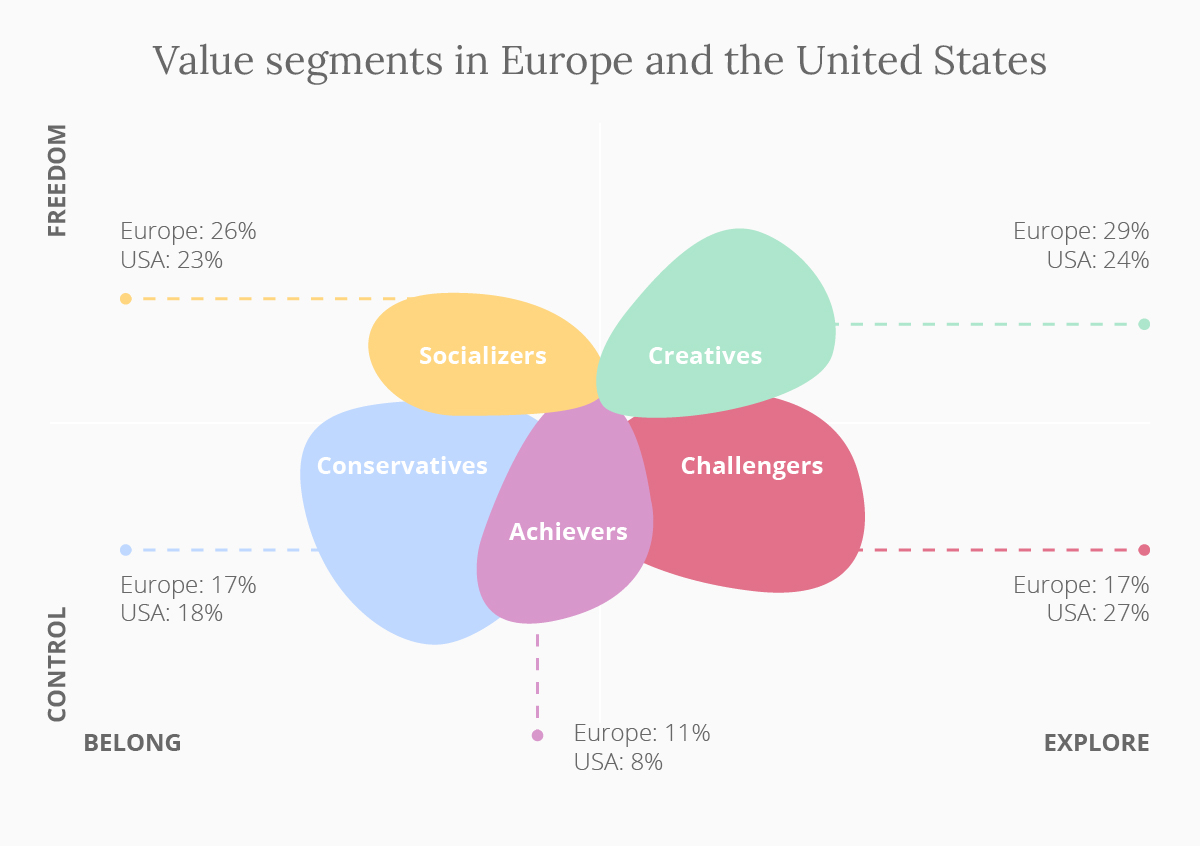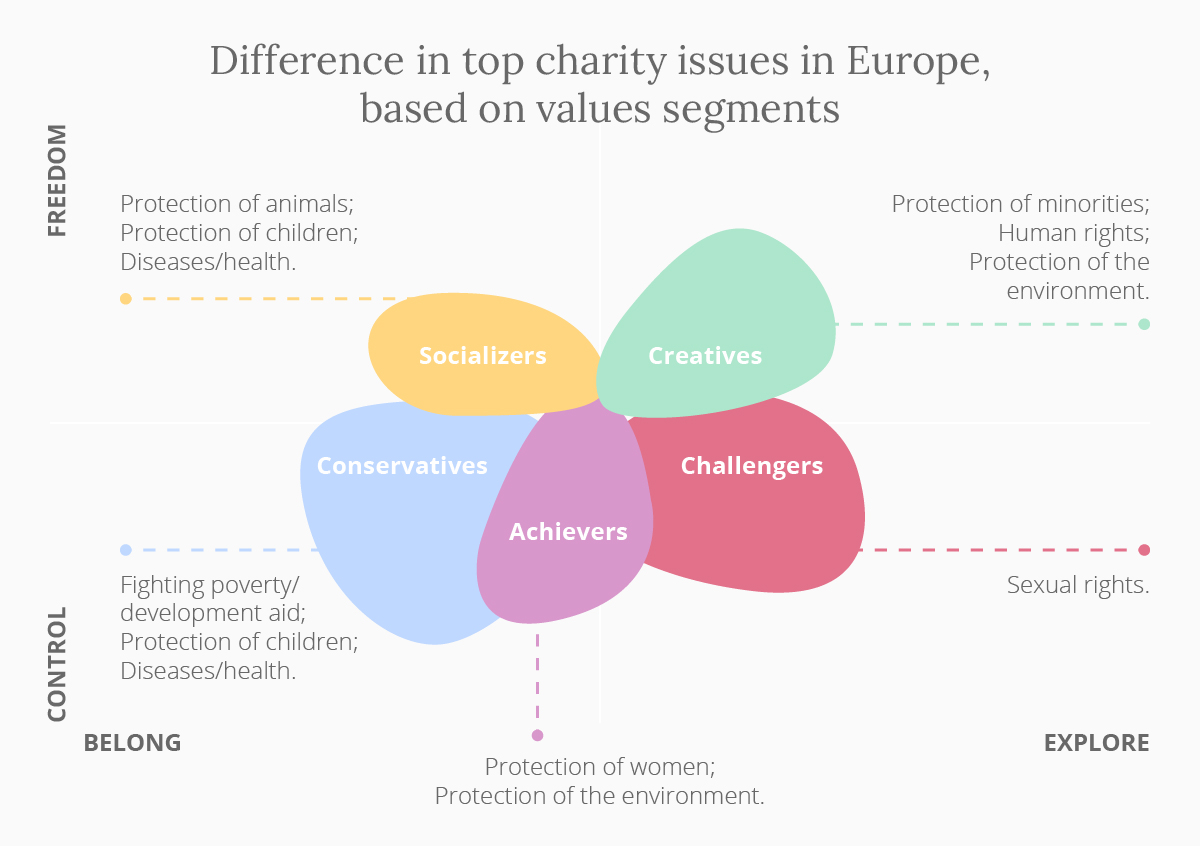
Much has been written on how Covid-19 has impacted business and marketing, however, there have been very few global and comprehensive studies on how the pandemic has affected the values and attitudes of consumers – and what this entails for communications and branding. Our study across 24 markets analyzed a comprehensive set of values and attitudes and identified 9 trends. We uniquely measured within-subject changes by surveying the same respondents twice in panels around the world, just before the pandemic hit most countries in early 2020 and again in November 2020. The resulting changes in consumers’ value patterns and attitudes are highly robust and influence what resonates with consumers – and, consequently, the brand communication targeting them.
We identified the following 9 trends:
- Rising fear and pessimism;
- Rising focus on postmaterialism and freedom;
- Declining focus on patriarchy and law and order;
- Rising support for emancipation and equality;
- Rising focus on sharing and community;
- Declining focus on hedonism, novelty, and beauty;
- Increased focus on health, vitality, and taking precautions;
- Ecological concerns rising – but less of a priority in practice;
- Rising emphasis on inclusive economic growth.
Rising support for emancipation and equality
The effect of these trends in values and attitudes is probably most visible already in communication when looking at emancipation, equality, and the declining support for patriarchy. Emancipation and equality values are boosted by the crisis and it’s probably no coincidence that the winner of the most effective campaign of 2020 is Heineken’s “Cheers to All” campaign, which focuses on the female premium beer drinker – traditionally a male domain.
Of course, there is much more behind this effectiveness success than just jumping on a trend – more on that later.
This combination of trends is also visible in the fourth most effective campaign of 2020 – the artistically executed “It Comes Naturally” Sheamoisture ad. Besides the emancipation trends, the ad combines several of the other identified trends. The declining focus on patriarchy, support for emancipation with the rising focus on sharing and community, and rising focus on postmaterialism.
That gender – and the hierarchy and inequality that comes with the patriarchic model – matters less these days and is also mirrored in the lifestyle and fashion trend of gender fluidity. From Gucci’s gender-fluid (or more correctly, genderless collection) to Bad Bunny’s Yo Perreo Sola video with almost 500 million views. Gender fluidity is on the rise among Gen Z and the frontrunners in this trend belong to the values segment of the Creatives, openminded, cosmopolitan, and highly emancipated consumers who see the urgency of their values reinforced as a result of the Covid-19 crisis.
Declining focus on hedonism, novelty, and beauty
Another strong sign of the times is the decline of hedonism, novelty, and beauty. The pandemic upheaval has refocused consumers on what really matters: relations, being together, and experiences. This, for instance, is also visible in the runner-up of the most effective campaign of 2020 – the emotionally, very poised, German Bosch Atino campaign. The campaign shows a young gentleman moving out of his parental home – but, before he moves out, he creates lasting memories by hanging up pictures of him growing up with his parents. The ad focuses on what really matters: deeper human bonds.
Undoubtedly, these campaigns would also have been successful two years ago, as the themes are universal, and the communication fits the brand image and the target audiences. They are all very well executed but they fit the zeitgeist and changing needs so much better now.
Heightened social engagement strengthens purpose
Together, these trends point to a heightened, social consumer engagement and that strengthens the business case of using sincere purpose brand communication and positioning. This strengthened business case is further confirmed by research recently published in The Economist. The Economist identified a stronger willingness of consumers to change their purchase intentions based on the societal issues companies support.
However, in consumer behavioral science, there is always an important gap between what consumers say and finally do. The shift in underlying attitudes and values makes the gap between what consumers say and what they do, smaller. After all, there are some fundamental reasons behind these changes in intentions.
According to Kantar, the previous year has seen a rise in purpose-based communication. However, using purpose or social trends alone does not make communication more effective. For these to be effective, they need to be in line with the brand and in line with the target audience – apart from having great execution.
According to Daren Poole, from Kantar, the driver of long-term effectiveness of using purpose is whether consumers perceive purpose to fit the brand. “On one hand, this means that brands that have never demonstrated any purpose in the way they conduct business may struggle to communicate it. It also means that brands that have an open/fun/outgoing personality may struggle with approaching purpose in a serious way.”
Just as important, our agency now has a large body of global research and experience that proves that it is crucial to look at the target audience of your respective brand and how trends and societal issues impact the brands’ target audience. This is also the case with purpose – different target audiences look at purpose, social and environmental issues, and trends in different manners – both in terms of the overall importance of purpose as well as the purpose themes and issues communicated by the brand.
For instance, we know that progressive parts of society, such as the earlier mentioned Creatives, are significantly more likely to translate the above trends into buying behavior than, for instance, the Socializers – sociability seekers who love entertainment, freedom, and family values.
In addition, clearly not every target audience is passionate about the same purpose issues. Creatives and Socializers, in Europe, have quite different issues they typically care about. For example, Creatives are more into the protection of minorities, human rights, and the environment, while Socializers are more into protection of animals, children, and combatting disease.
Also, Creatives are much more critical about the sincerity and authenticity of purpose-based communications. If it is not perceived as sincere or authentic and if it’s not in line with the brand’s products, operations, and positioning, they are the first to lose trust and criticize. Communications about brand purpose is walking a fine line between the actual brand identity and the projected and aspired image – and not losing your authenticity while doing it.
As such, it is vital to align your brand positioning, purpose, and communication with the societal issues your target audience cares about. In these times of accelerating societal change, it is even more important to keep the pulse of international trends and audiences.
Or, as an anonymous marketer puts it, “The trend is your friend if your brand and audience are in the blend.”
Cover image source: Anna Shvets
–
Co-written with Martijn Lampert, co-founder and research director at Glocalities.


